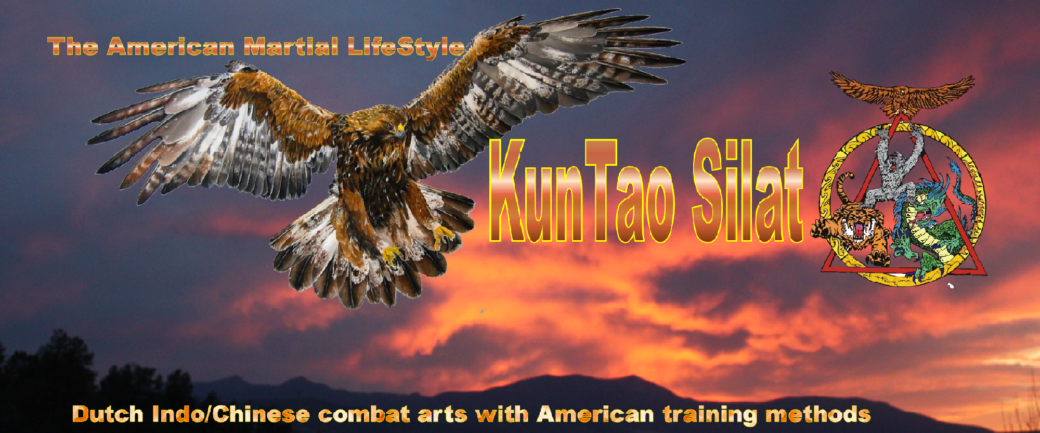Welcome to KunTao Silat ~ the American Martial LifeStyle › Forums › General Category › Ratings and Reviews › Golden Demonstration: a review worth reading
- This topic has 0 replies, 1 voice, and was last updated 15 years, 4 months ago by
Anonymous.
-
AuthorPosts
-
-
January 28, 2010 at 2:15 am #424
Anonymous
InactiveKunTao Silat Gold! 🙂This DVD presents a KTS demonstration given at the Golden, CO rec center in 1996. Designed as a relatively speedy overview of the system, this demonstration opens with a little history, and quickly proceeds to the internal aspects of the art. SiGung Steve shows what is either a TaiKeh (sp?) form or a kembaggan working on similar principles. SiGung Steve's improvisation usually looks like he planned it that way all along, so it's hard to tell. The attendant discussion was particularly interesting to me, because a year into my own Sera(k) training, I had to go find a health practice in order to continue -- the training was absolutely destroying my lower back and knees. It's good to see the health aspects being cultivated within the art itself; sustainable practice is key for Americans, who typically expect to live well beyond their forties and don't like to destroy their bodies for the purpose of learning to preserve them. What SiGung Steve says here is not particularly detailed, but there's more on this aspect of the system than I've seen in other ThunderRock DVDs, and I have most of them. If this aspect of KTS interests you, this is a must-have DVD for this material alone.In the next portion of the demonstration Guru Ted Garcia and Guru Muda Rob Snazza took the floor to demonstrate the first three forms and a series of applications from same. Guru Garcia then takes the floor to show Pai Yun and Ling Sing Toy, with a series of applications from each. SiGung Gartin takes over to show a few applications of his own. I don't really know what to say about the applications without going through each one. If you've seen some material from ThunderRock before, you know what you're getting. If you don't, you're in for a treat--brutal efficiency and martial ingenuity like you've never seen it before.At this point Pak Chas takes the floor. His lecture begins with the words "If I hadn't had quite a bit of martial art last night when I got hit by the forklift, I probably would be a lot more hurt than I am right now" and proceeds from there in typical Chas-ian fashion. The initial lecture covers a number of aspects of arranging the mental furniture for effective self-preservation. His demonstration focuses on the older person's art, as direct and nasty as anything shown earlier, but more physically upright, depending less on agility and speed, and more on experience and perhaps a deeper understanding of anatomical vulnerabilities. (Not to say that SiGung Steve doesn't also exhibit such knowledge, but the younger man's art holds the potential to overwhelm the opponent with sheer agility and hyperactivity; all the damage is in addition to that. By contrast, the older man's art doesn't exhibit that kind of physicality, and so *depends* on a very sudden and intrusive attack to vulnerable places.)Pak Chas also includes a very nice discussion of the fighting cane. As with KTS (and silat generally), the principles and applications are somewhat...unique, let's say...in the martial arts world. The material presented here could keep someone's practice going for months at the very least.In the closing portion of the program, April Rose Gartin takes the floor for a demonstration of kids' kuntao, focusing on stance work and animal attitudes. We see this kind of thing on a number of ThunderRock videos, and it's a real untapped strength for the Distance Learning Program. In the future I'm hoping we will see a whole DVD--if not a whole series--devoted to training children. Homeschoolers in particular often look for PE-type activities that suit the whole family together. The village nature of KTS suits that kind of familial training environment, and we have people with experience conveying the material at a distance. There's an untapped market there, if we could package the material properly. (Of course, this would be a sizable shift in direction for the way KTS typically propagates, since our average "beginner" is an adult with advanced rank in something else, and has long since learned how to fall, make a fist, and so on.) I'm just sayin'....One thing that was emphasized (and repeatedly proven) throughout the demonstration, and deserves mention: KTS fights like it trains. We use the forms. Unlike many other systems where bunkai is some sort of advanced discipline or closely guarded secret teaching, interpretation of the KTS forms is part of training from day one -- if it wasn't, how would we fight?{by Timothy Nichols}
-
-
AuthorPosts
- You must be logged in to reply to this topic.
Share this:
- Click to share on Facebook (Opens in new window) Facebook
- Click to share on X (Opens in new window) X
- Click to share on LinkedIn (Opens in new window) LinkedIn
- Click to email a link to a friend (Opens in new window) Email
- Click to print (Opens in new window) Print
- More
- Click to share on Pinterest (Opens in new window) Pinterest
- Click to share on Reddit (Opens in new window) Reddit
- Click to share on Tumblr (Opens in new window) Tumblr
- Click to share on WhatsApp (Opens in new window) WhatsApp
- Click to share on Pocket (Opens in new window) Pocket
- Click to share on Telegram (Opens in new window) Telegram
